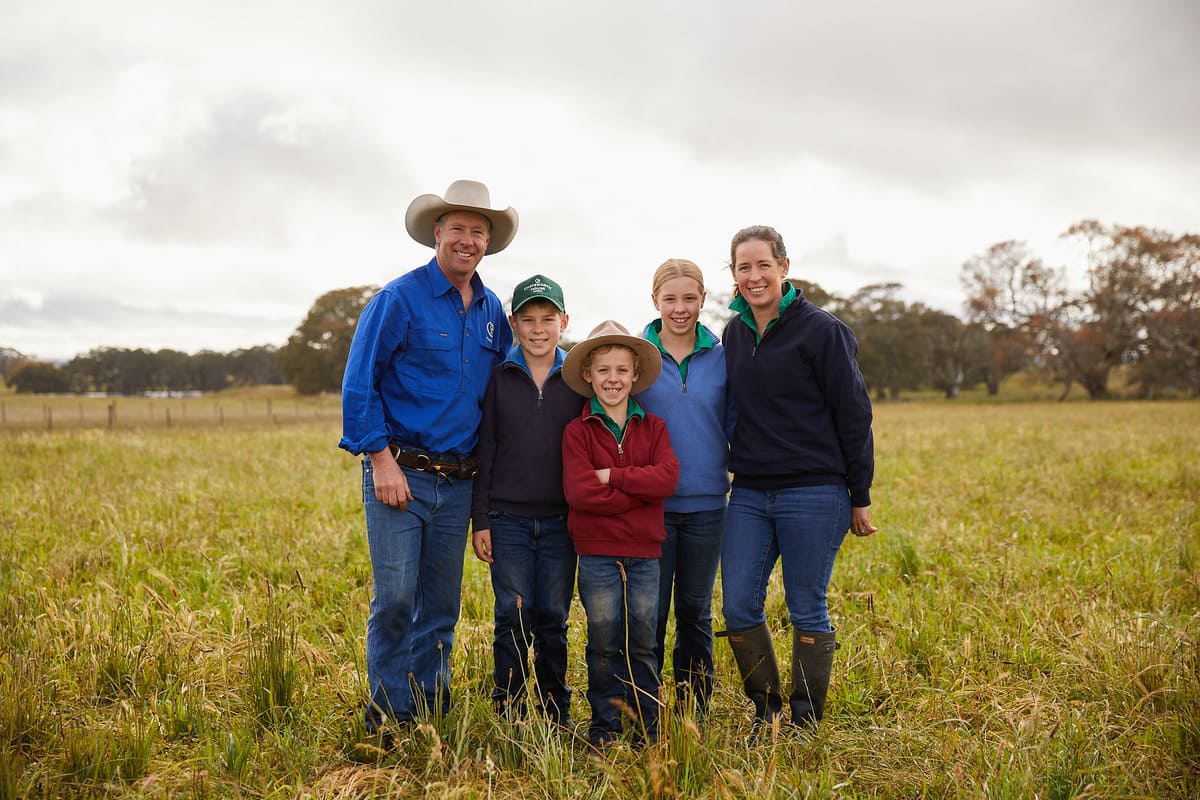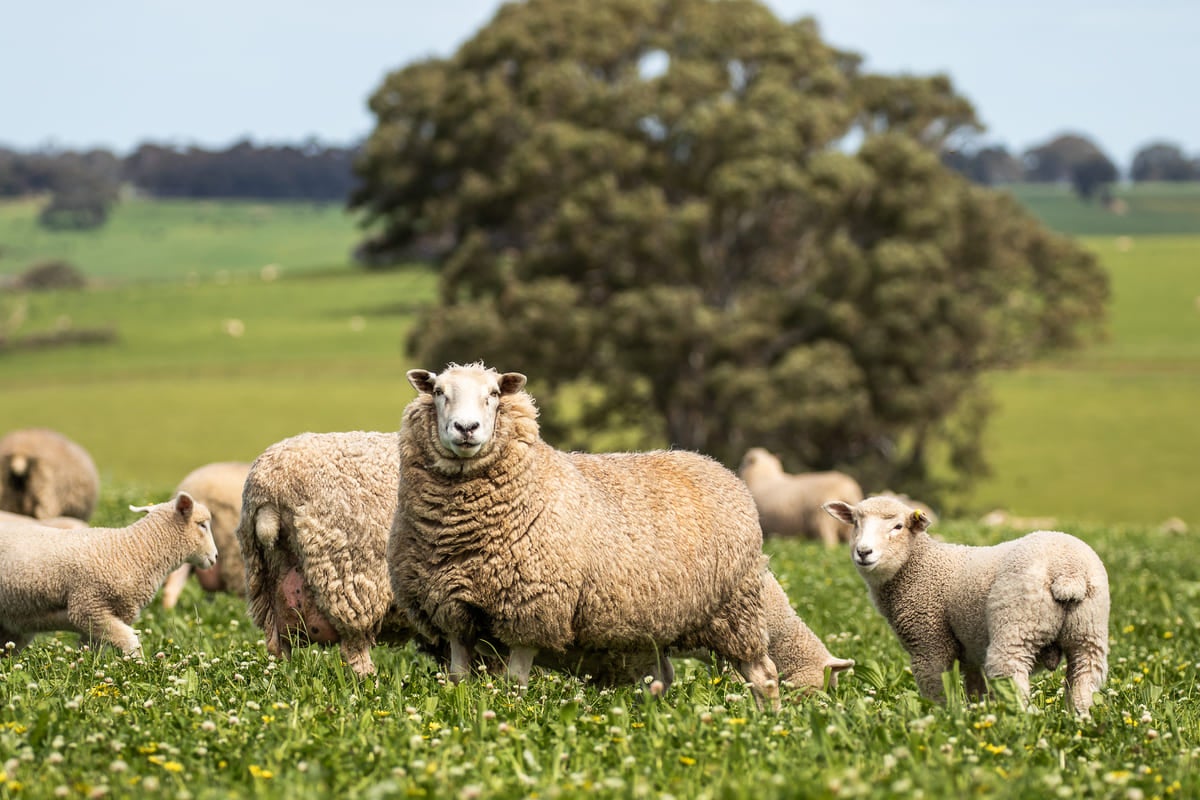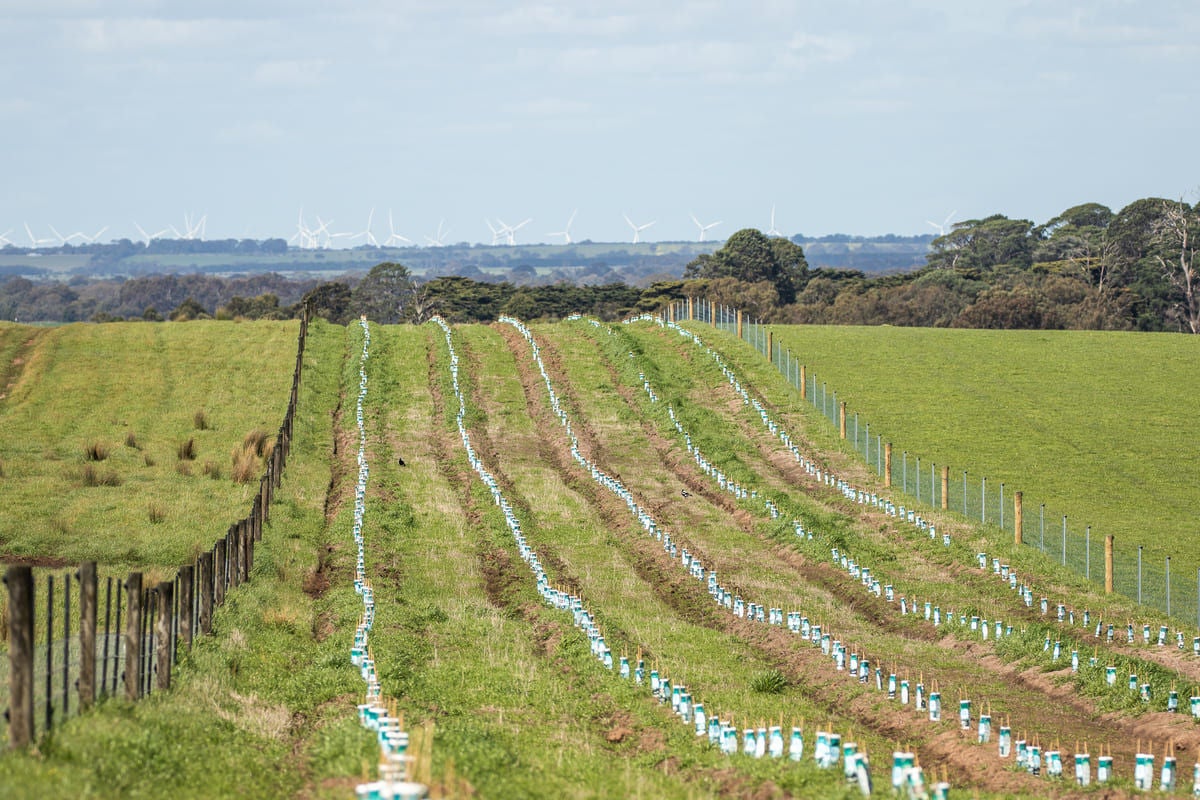Posted by on
05/06/2025
Sarah and Tom Whinney’s deep connection to the environment, agriculture, and the people who make up their family, farming business, and wider community is evident in their passion and dedication to regenerating the landscape under their custodianship.
Running around 35,000 DSE of prime lambs, beef breeding and trading cattle, Tom, Sarah, and their three young children have transitioned their business, Chatsworth House Pastoral, toward regenerative practices since moving to Chatsworth House in western Victoria in early 2020.
This shift, they say, aligns with their values and their growing understanding of nature’s interconnectedness, gained through continual learning and surrounding themselves with like-minded people and mentors.
“Everyone’s journey is different, and you can only do the best you can with the knowledge you have at any given time. For us, having a personal coach and opening up our mindset has been really important,” Sarah says.
Tom agrees, adding, “It’s all about getting the right people around you – mentors, farming groups and others who support your direction.”
While their love of environment and landscape stems from childhood, their learning accelerated after having children and wanting to do the best for their own children’s health, sparking a “gut health journey”. Simultaneously, they were also starting to gain a greater appreciation of the importance of soil health, which they now consider their “main asset”. They then began to see parallels between gut and soil biomes and began seeking a more holistic approach.
“We went off on a few tangents,” Sarah recalls. “Then we discovered the term ‘regenerative agriculture,’ and everything started to click.” From there, they immersed themselves in books, podcasts, videos, and conversations with others in this space.
“We then started pulling everything together,” Sarah says. “If you look after the soil, you have healthy plants, healthy animals, healthy people, and you can help the climate as well.”

Image: Georgie Mann Photography
These insights spurred their transition from a high-input mixed farming operation at Mount Hamilton, where their enterprise was split 50-50 between cropping and livestock, to a livestock focused operation on 2400 hectares at Chatsworth House in early 2020.
“As we moved more towards regenerative practices, we realised you have to be really passionate about it,” Tom says. “I wasn’t passionate about cropping, and Chatsworth House, with its steep hills and trees, is better suited to livestock.”
The move, while significant, has been a “better fit for us,” Sarah adds.
Now running approximately 75 per cent prime lambs and 25 per cent trading and breeding cattle, the Whinneys view livestock as “key” to managing their natural capital. This sees them focus on rotational grazing, retaining groundcover, matching their stocking rate to the land’s carrying capacity and low-stress stock handling.
Integral to this has also been increasing the diversity of their summer crops and perennial pastures, which they describe as a “salad bowl” instead of “the monocultures we used to grow”. They use multi-species fodder crops to prime the soil, followed by perennial pastures, including phalaris, cocksfoot, fescue, clover, lucerne, chicory, and plantain.
They also focus on reducing synthetic fertilisers and inputs whilst incorporating humates, fulvic acid, compost extract, and biostimulants, which they use to coat their seed. “It is about earning the right to use less chemical,” Sarah says. “When you get a healthier system, you don’t have to; the need is not there.”
With their practices relating to soil health principles, the couple say their farming system is now more resilient and flexible, particularly during drier times with more levers to pull.
“We don’t believe the high input, high stocking rates system was sustainable for us or this property,” Tom says. “We now manage it with a focus on flexibility to better manage fluctuations in the season and build resilience into the property and our business.”
“We now seem to stay greener for longer; extending our seasons, while our animal health has improved a lot,” Tom notes, citing reduced worm burden, less mastitis in ewes, and fewer lambs needing crutching.
The couple has also noticed marked improvements in their soil structure and organic matter. “When we are out with the agronomist, we always take a shovel and look at the soil,” Sarah says. “In some paddocks, we’re seeing more aggregation, deeper roots, and less compaction. There’s life in the soil.”

Image: Georgie Mann Photography
As part of their commitment, the Whinney’s have registered a soil carbon project with the Australian Government Clean Energy Regulator.
They have also joined the Ecological Outcome Verification (EOV) program, associated with Land to Market.
“We want to be able to tell our story authentically, with real data to back it up,” Sarah says.
With the couple drawn to the program due to its “outcome-focus,” whereby ecological indicators, including groundcover, water infiltration, biodiversity, soil carbon and soil health, are monitored on both short and long-term sites.
“It is not saying you need to be organic or dictating what you can and can’t do. Instead it is saying, you do the practices that work for you, and we’ll measure if you are improving the land that you are managing.”
Although they haven’t realised a premium from the Land to Market Verified seal yet, Sarah says it could open up opportunities for branded paddock-to-plate products in the future.
The Whinneys also have a whole farm plan that they prepared when they first moved to Chatsworth House to outline their priorities for the development of the property. This includes fencing and water infrastructure, pastures and tree planting. They have already achieved many things in the plan, including having around 12,000 trees planted to date as shelterbelts, along fence lines, and in riparian zones.
“A lot of the creeks already have beautiful old red gums, but the hilltops have very few trees on them,” Tom says. “So it would be really nice to get some of those ridges planted out to protect it from the wind and also attract birds and livestock to spend time up there.”

Image: Georgie Mann Photography
Tom says their motivation to try and increase biodiversity and regenerate the natural environment comes from a desire to work closely in line with our values.
Sarah agrees, adding, “It all comes back to our core values – we are passionate about what we do and value accountability and respect. We also focus on fostering teamwork, curiosity, and innovation. Underpinning all this is kindness and caring; we care deeply for those in our team, our families and our communities.
“Living and working according to your values not only feels good but keeps you motivated to stay true to those values.” she says.
Looking ahead, the Whinneys say they hope to “continue to learn and refine what we are doing” in terms of “profitably regenerating” their natural capital.
“It is intrinsically in us to want to share what we’ve learned and help others,” Sarah says. “In saying that, we still have so much to learn, and so many people are further along the journey than us.”
Tom concurs: “For us, it’s about helping others. We hope that by sharing our story others may be inspired to look at ways of improving their natural capital.”
Disclaimer: This case study is published by Rabobank Australia Limited ABN 50 001 621 129 AFSL 234700 and Coöperatieve Rabobank U.A. (Australia Branch) ABN 70003917655 AFSL 238446 (together, “we” or “us”). The information in this case study is based on information provided to us by the clients to whom it relates. We have attempted to accurately reflect that information in this case study but do not represent, guarantee or warrant that is complete or accurate. The views and opinions expressed are those of the clients quoted as making them or are paraphrased from information provided by them, and reflect their experiences and judgements. Accordingly, no part of this case study constitutes advice and should not be relied upon as a basis for any business or financial decisions. We do not accept any liability for any loss or damage arising out of any error or omission in this publication or arising out of any reliance or use of this publication or its contents or otherwise arising in connection therewith. This publication may not be reproduced or distributed in whole or in part, except with our prior written consent.
